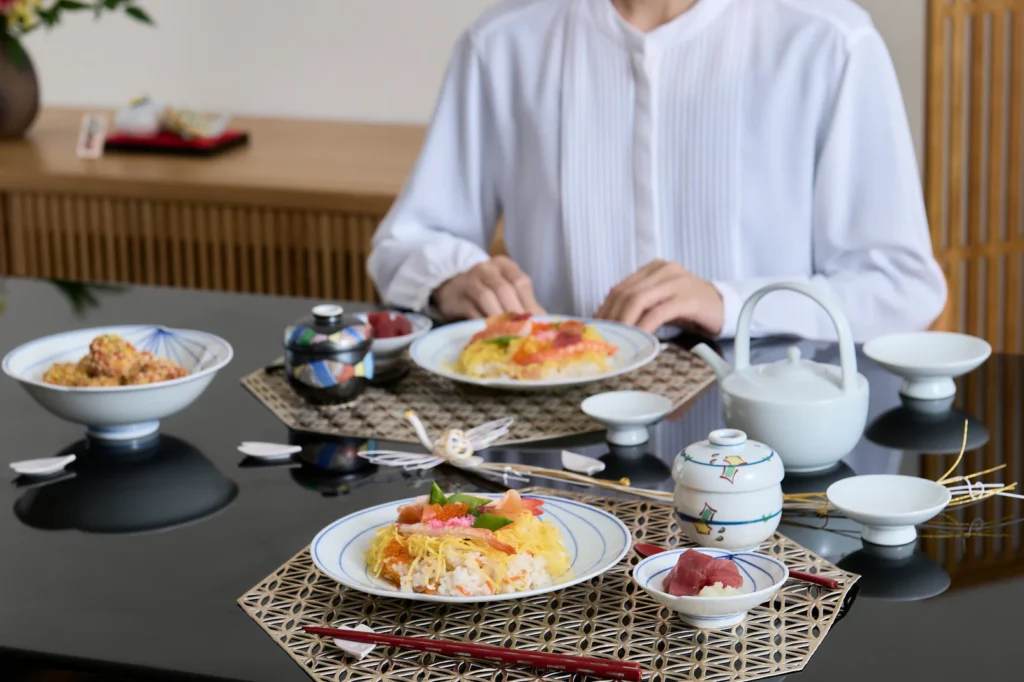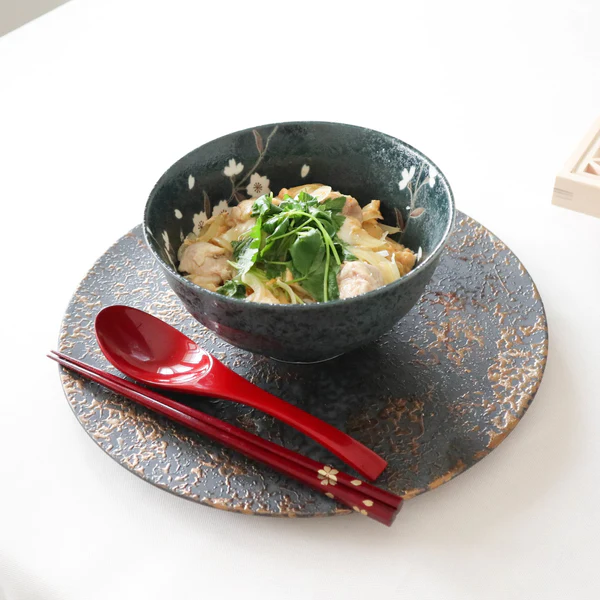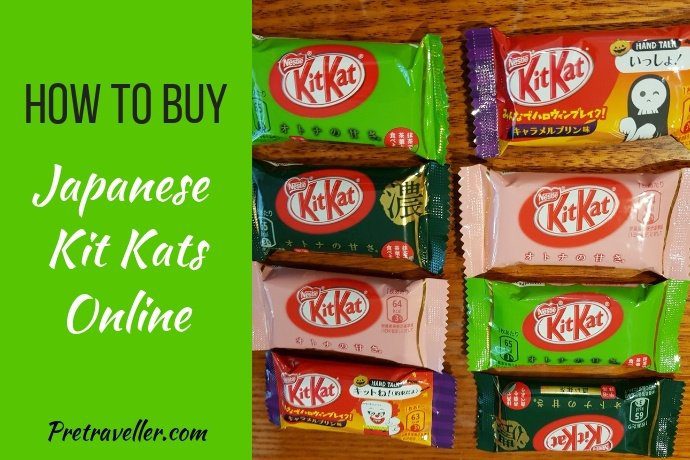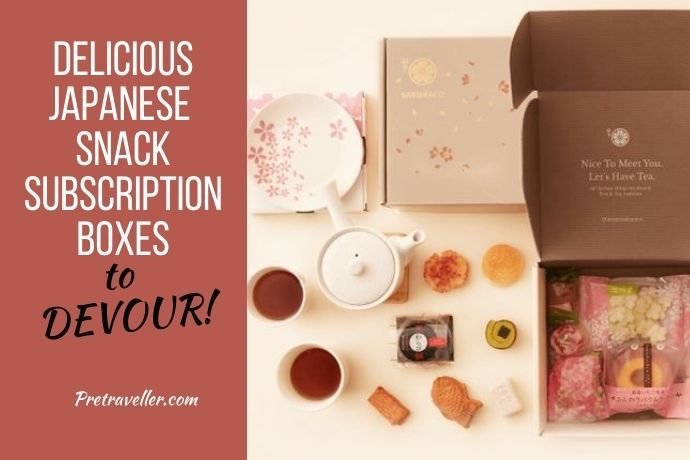Welcome to the fun world of Japanese-themed dinner parties, where tradition meets elegance, and every detail contributes to an immersive cultural experience.
Japanese cuisine is renowned for its refined simplicity and emphasis on seasonal ingredients, but the dining experience extends far beyond the food itself. The magic lies in the presentation, ambience, and authentic tableware, decor, food and activities that transport you and your guests straight to the heart of Japan.
In this guide, we’ll explore how to create an authentic Japanese dining experience in your home, focusing on the key elements that make these gatherings special and memorable.
Disclaimer: This article contains affiliate links. That means that if you make a booking after clicking on a link it may mean that we receive a small commission at no extra cost to you. Thank you!
As an Amazon Associate we earn from qualifying purchases
Understanding Japanese Dining Etiquette and Decorum
Before diving into the details of tableware and decor, it’s essential to have a basic understanding of Japanese dining etiquette and decorum. This knowledge not only enhances the authenticity of your party but also shows respect for the rich cultural traditions of Japan.
Brief Overview of Traditional Japanese Dining Etiquette
- Seating Arrangements: Traditionally, Japanese dining involves sitting on tatami mats around a low table. However, you can adapt this by arranging floor cushions around a coffee table for a similar effect or setting your dining table in the Japanese style.
- Chopstick Etiquette: Chopsticks are an integral part of Japanese dining. Some key rules include not pointing with chopsticks, not passing food directly from chopstick to chopstick, and avoiding sticking chopsticks upright in a bowl of rice. For guests not familiar with using chopsticks, you can provide easy Western alternatives with no fuss.
- Serving Style: Japanese meals often consist of multiple small dishes served simultaneously. Each dish has its designated tableware, contributing to the overall aesthetic of the meal.

Significance of Presentation and Setting in Japanese Culture
- Harmony and Balance: The arrangement of food and the choice of tableware are guided by a sense of harmony and balance. Colors, shapes, and textures are carefully considered to create a pleasing visual experience.
- Seasonal Awareness: Seasonality plays a vital role in Japanese cuisine and decor. Incorporate seasonal flowers and motifs in your table setting to reflect this aspect.
- Minimalism and Elegance: Japanese aesthetics value minimalism and natural elegance. Keep your table setting simple yet sophisticated, avoiding clutter and embracing natural materials and colors.
Understanding these fundamental aspects of Japanese dining culture will set a solid foundation for hosting your Japanese-themed dinner party, ensuring an authentic and respectful representation of this rich and beautiful tradition.
Japanese Dinner Party Decorations
Creating an authentic Japanese dining atmosphere involves more than just the food; it’s about the entire setting. Here are three thematic options for your Japanese dinner party, with alternatives to traditional tatami mats and low tables.
For those with standard Western-style dinner tables, we’ll explore how to transform these into a Japanese-themed setting. Additionally, we will recommend appropriate products from Amazon.com and Musubi Kiln to help create each theme.
Option 1: Traditional Japanese Elegance
- Theme Description: This theme replicates the serene and minimalist aesthetic of a traditional Japanese dining room.
- Table Setting: Use a neutral-colored tablecloth to mimic the simplicity of tatami mats. Place bamboo placemats for each guest.
- Recommended Products:
- Bamboo Placemats: Perfect for adding a natural touch to your table.
- Japanese Style Dinnerware Set: Includes sushi plates, bowls, and soup spoons for an authentic dining experience.
Option 2: Modern Zen
- Theme Description: A contemporary take on the Japanese aesthetic, combining modern elements with traditional Japanese design.
- Table Setting: Choose a monochromatic color scheme. Incorporate clean lines and minimalistic decor items like a simple Ikebana flower arrangement.
- Recommended Products:
- Zen Garden Table Centerpiece: Adds a modern Zen feel to your table.
- Contemporary Japanese Dinnerware Set: Sleek and modern, yet distinctly Japanese in design.
- Authentic Japanese Vase. Select a feature Japanese Vase to set off your decor.
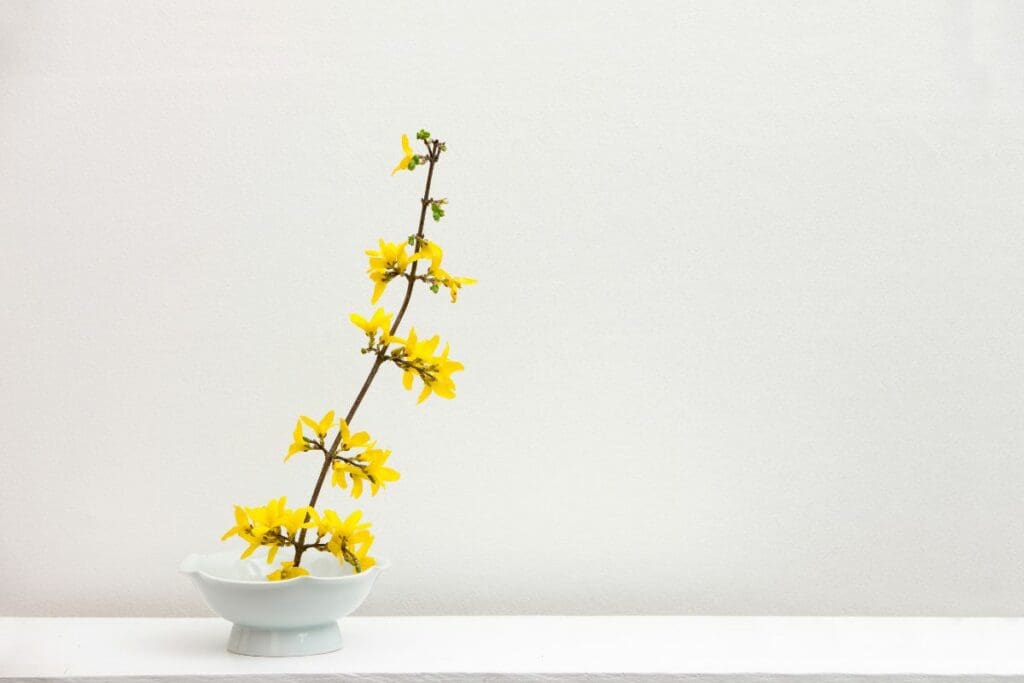
Option 3: Sakura Blossom Festival
- Theme Description: Inspired by the cherry blossom season in Japan, this theme is vibrant and colorful, celebrating the beauty of nature.
- Table Setting: Use a cherry blossom table runner, and place pink and white accents around the table. Small sakura-themed decorations can enhance the festive feel.
- Recommended Products:
- Cherry Blossom Table Runner: Brings a burst of color and thematic focus to your table.
- Sakura Flower Dinnerware Set: Features beautiful cherry blossom designs, perfect for a springtime theme.
Adapting to a Western-Style Dinner Table
- Centrepieces: Choose centrepieces that align with your chosen theme. For example, a Zen garden for the Modern Zen theme, or a cherry blossom arrangement for the Sakura Blossom Festival.
- Tableware Placement: Arrange the tableware in a way that reflects Japanese aesthetics. Use matching sets for a cohesive look, and consider the visual balance of the table.
- Decorative Elements: Add small touches like folded origami at each place setting or Japanese lanterns around the room. These elements can significantly enhance the overall theme without needing a complete overhaul of your dining space.
By carefully selecting and arranging these elements, you can transform a standard Western dining table into an authentic Japanese-themed setting, offering your guests an immersive cultural experience.
Planning Your Japan Dinner Party Menu
Creating a menu for your Japanese-themed dinner party involves more than just picking dishes; it’s about presenting a culinary journey through Japan. Here are ten classic Japanese recipes, each with a brief overview and their names in both English and Japanese characters. To enhance the dining experience, we’ve paired each dish with a complementary piece of tableware from Musubi Kiln.
1. Sushi Platter (寿司 – Sushi)
- Overview: Sushi is a renowned Japanese dish featuring vinegared rice combined with various ingredients like seafood and vegetables.
- Recipe: Classic Sushi Rolls
- Presentation: Serve on a Long Rectangular Plate from Musubi Kiln.
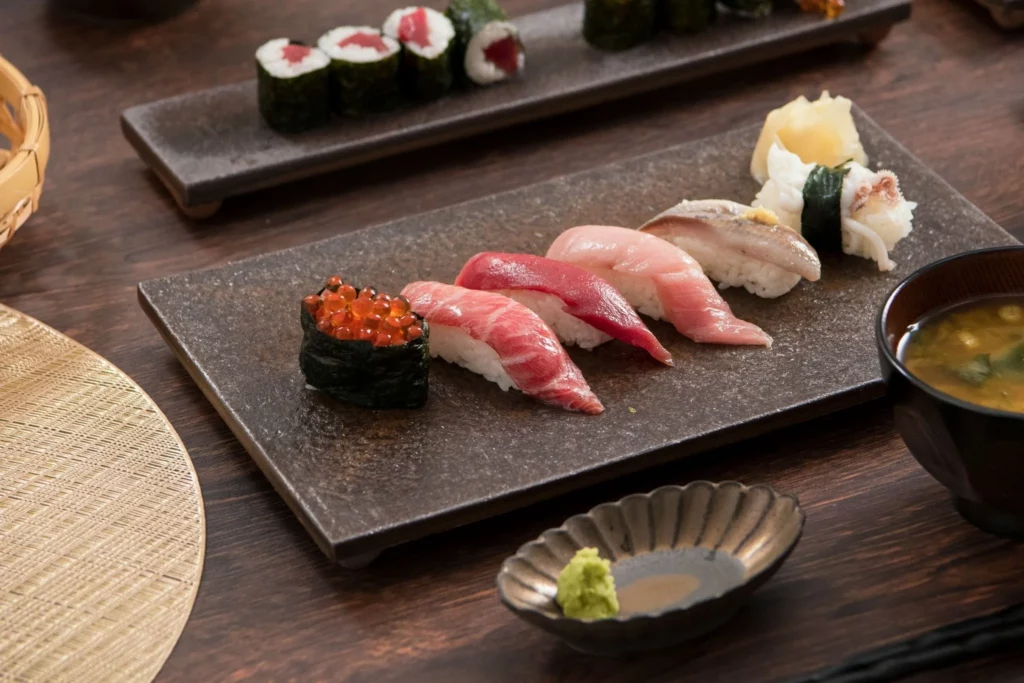
2. Sashimi (刺身 – Sashimi)
- Overview: Sashimi consists of fresh, thinly sliced raw fish or meat, often served with soy sauce and wasabi.
- Recipe: Basic Sashimi
- Presentation: Arrange on a Wave Crest Series Plate from Musubi Kiln.
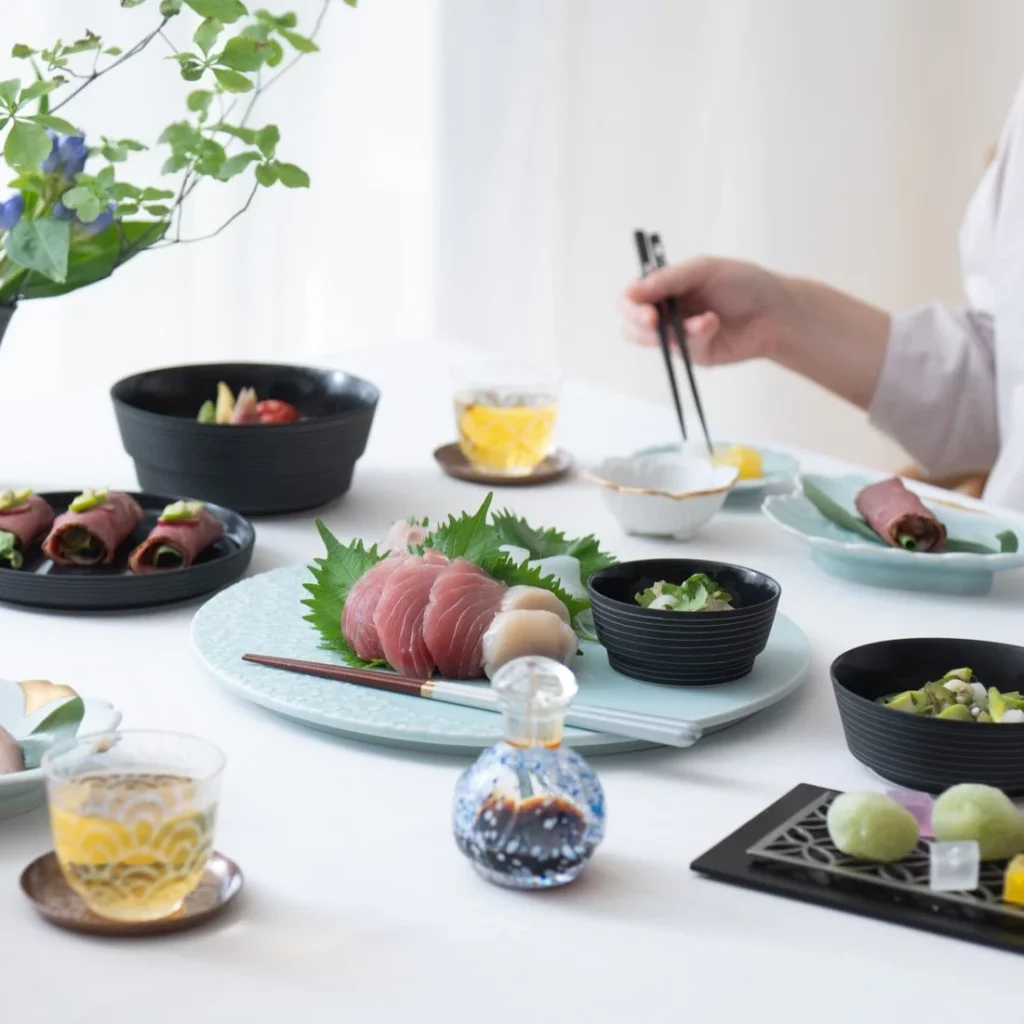
3. Tempura (天ぷら)
- Overview: Tempura is a dish of seafood or vegetables that have been battered and deep fried, known for its light and crispy texture.
- Recipe: Shrimp and Vegetable Tempura
- Presentation: Display on a Square Japanese Plate from Musubi Kiln.
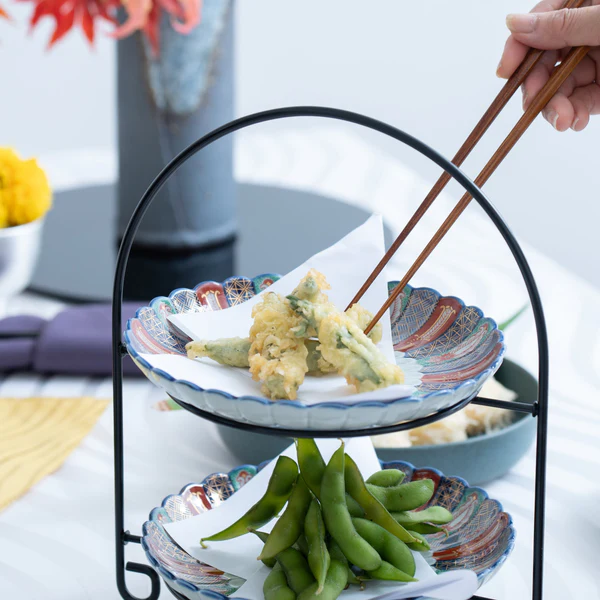
4. Miso Soup (味噌汁 – Miso Shiru)
- Overview: A traditional Japanese soup consisting of a stock called “dashi” mixed with miso paste, often containing tofu and seaweed.
- Recipe: Traditional Miso Soup
- Presentation: Serve in a Miso Soup Bowl from Musubi Kiln.
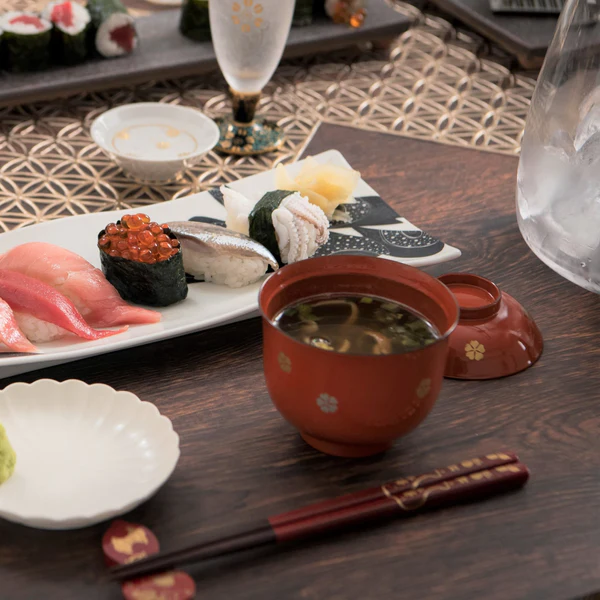
5. Japanese Curry (カレーライス – Kare Raisu)
- Overview: A hearty, mildly spicy curry made with meat and vegetables, served over rice. It’s thicker and sweeter compared to Indian curries.
- Recipe: Japanese Curry Rice
- Presentation: Offer in a Donburi Bowl from Musubi Kiln.
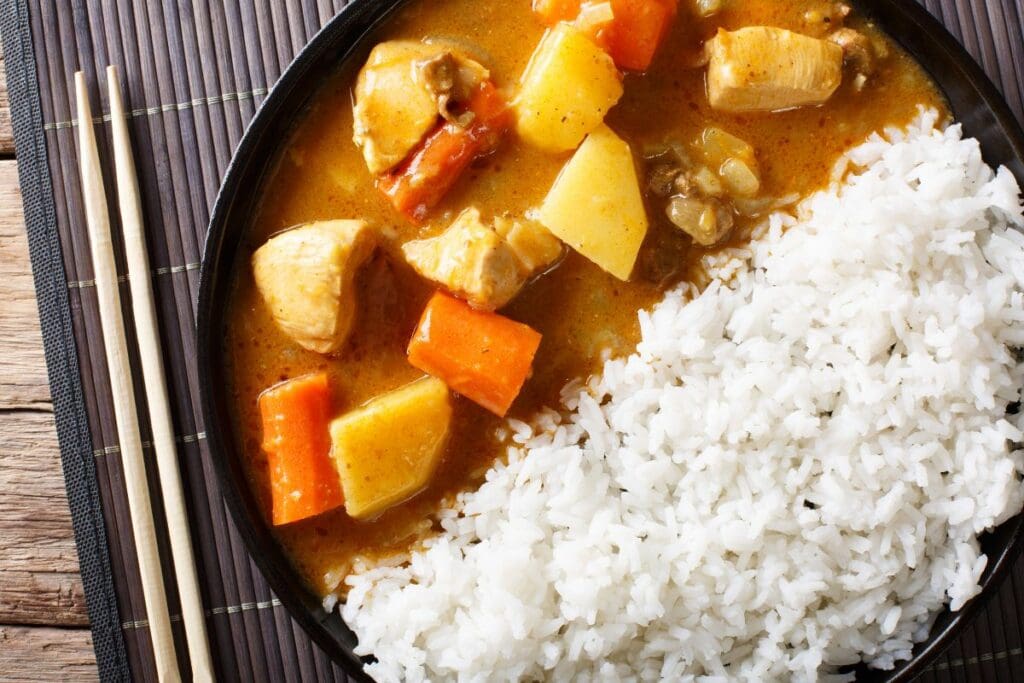
6. Yakitori (焼き鳥 – Yakitori)
- Overview: Yakitori are skewered and grilled chicken pieces, seasoned with salt or a sauce called tare.
- Recipe: Yakitori Recipe
- Presentation: Place on a Long Rectangular Plate from Musubi Kiln.
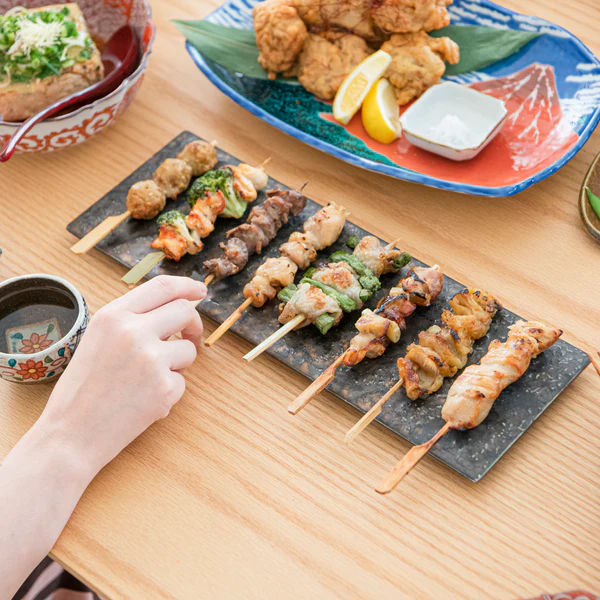
7. Japanese Omelette (卵焼き – Tamagoyaki)
- Overview: Tamagoyaki is a sweet, layered omelette that’s rolled into a log and sliced. It’s a common item in bento boxes.
- Recipe: Tamagoyaki
- Presentation: Serve on a Square Japanese Plate from Musubi Kiln.

8. Chawanmushi (茶碗蒸し – Chawanmushi)
- Overview: A savory egg custard, steamed and served in a cup, often containing small pieces of chicken, shrimp, and vegetables.
- Recipe: Chawanmushi
- Presentation: Serve in a Chawanmushi Cup from Musubi Kiln.
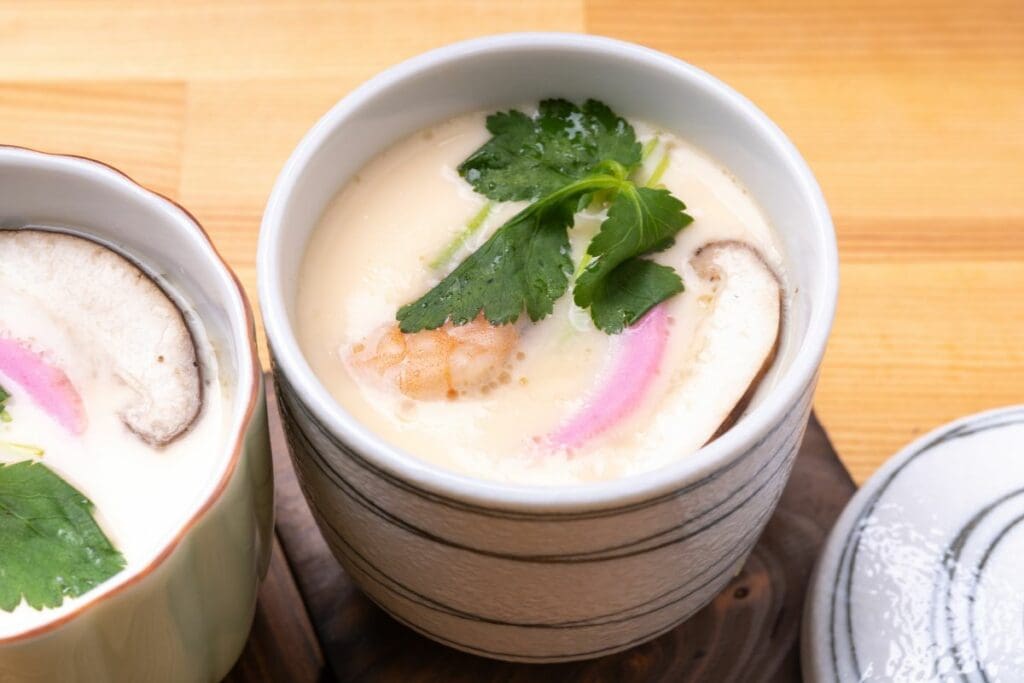
9. Green Tea Ice Cream (抹茶アイスクリーム – Matcha Aisu Kurīmu)
- Overview: A sweet, creamy ice cream flavored with matcha (green tea powder), offering a unique blend of sweetness and the distinct taste of green tea.
- Recipe: Matcha Green Tea Ice Cream
- Presentation: Scoop into a Small Japanese Bowl from Musubi Kiln.
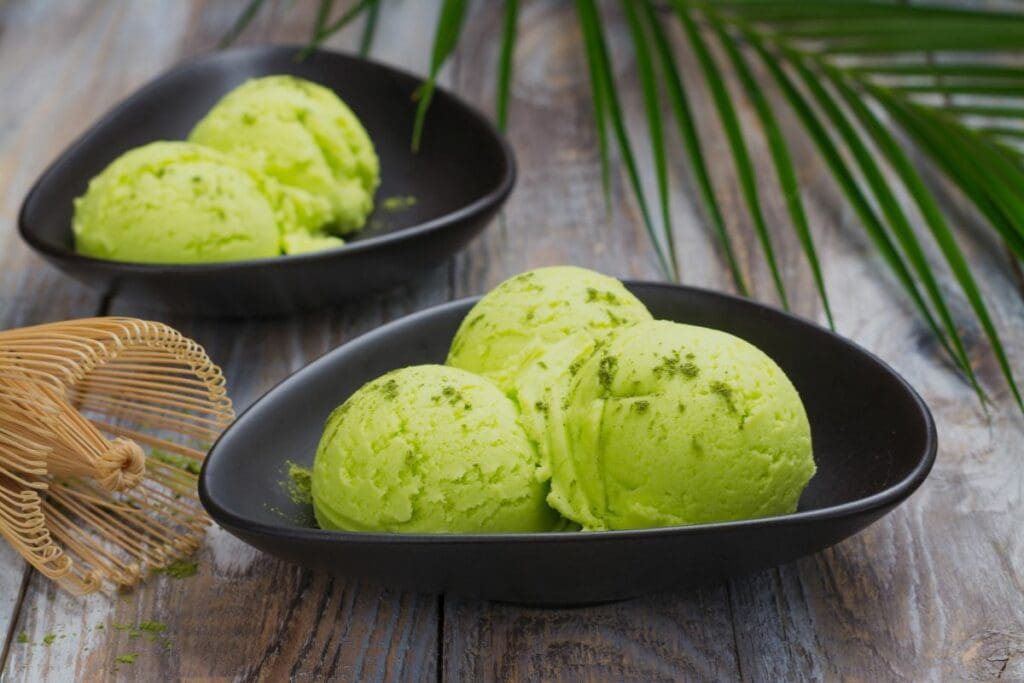
10. Sake (日本酒 – Nihonshu)
- Overview: Sake is a Japanese rice wine, served either chilled or warmed, and is a perfect complement to many Japanese dishes.
- Presentation: Serve in a Sake Cup Set from Musubi Kiln.
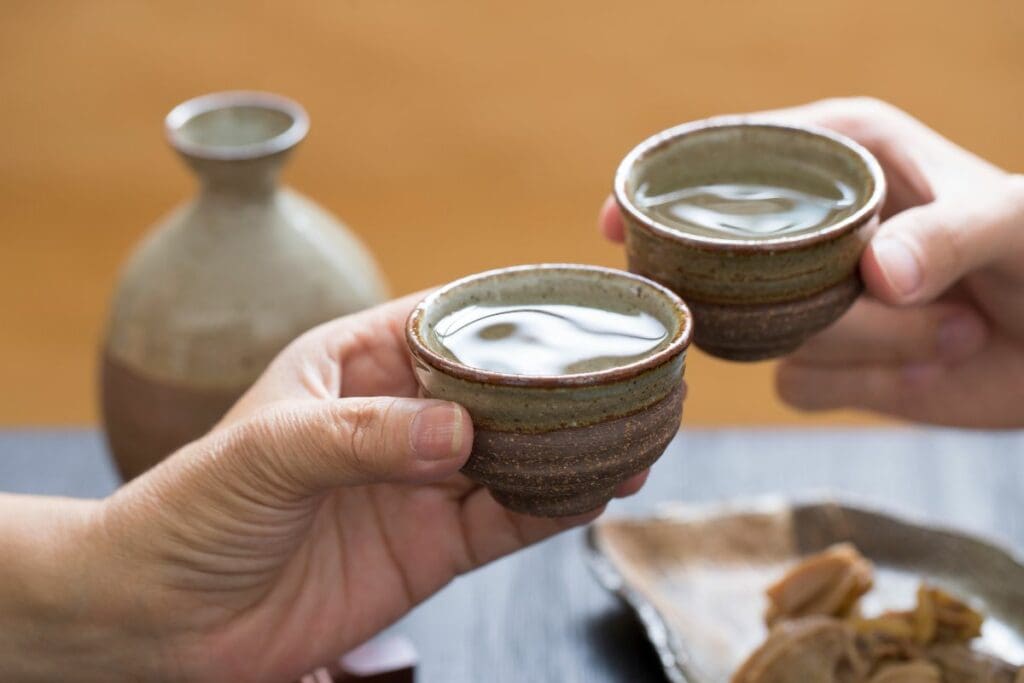
Each dish on this menu is not only a delight to the taste buds but also a feast for the eyes, especially when paired with the right tableware from Musubi Kiln. The presentation of each dish reflects the Japanese aesthetic of wabi-sabi, embracing simplicity and naturalness, which enhances the overall dining experience.
Dress Code: What to Wear for a Japanese Themed Dinner Party
When hosting a Japanese-themed dinner party, the attire can significantly contribute to the ambience and overall experience. Here are our suggestions for both hosts and guests to dress in a way that complements the theme of the evening.
For the Host:
- Yukata or Kimono: Wearing a traditional Japanese yukata for women and men (a casual summer kimono) or a more formal kimono can set a tone of authenticity and respect for the culture. Choose a yukata or kimono with patterns that are not too elaborate for a balanced and elegant look. Make sure you also purchase an Obi belt and hair accessories!
- Modern Twist: If traditional clothing is not available, opt for attire in solid colors that mimic the subtle elegance of Japanese fashion. Simple, clean lines and minimal accessories reflect the aesthetic.
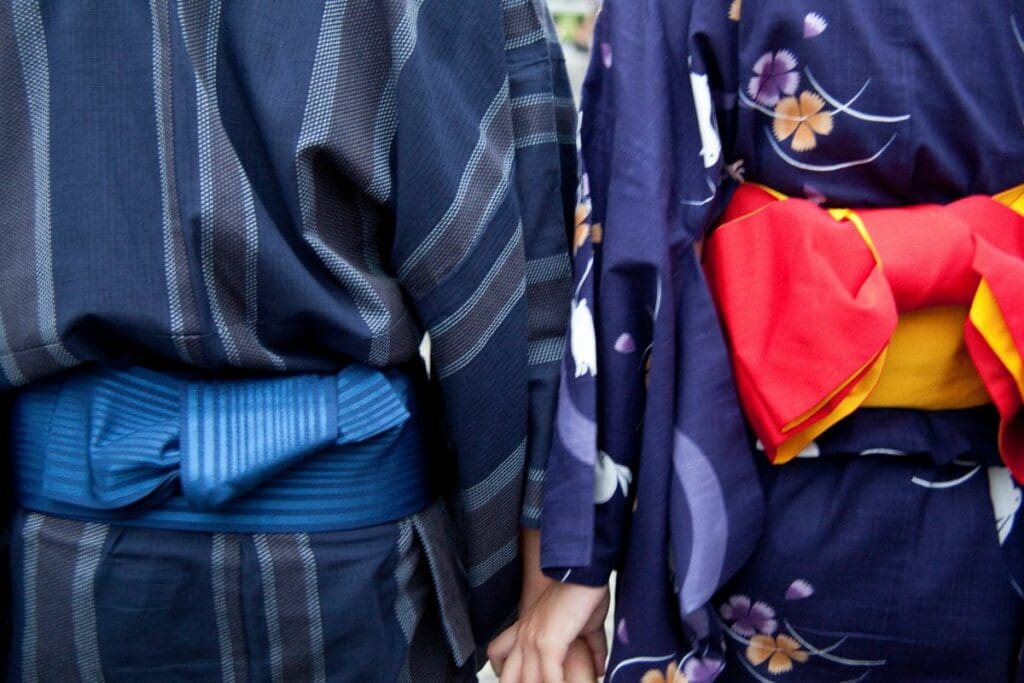
For the Guests:
- Suggested Attire: Encourage guests to wear attire that is inspired by Japanese colors and patterns. This could include clothing with floral motifs, solid colors, or even accessories like a scarf or tie with a Japanese design.
- Comfort First: Remind guests that comfort is key, especially if sitting on floor cushions is part of the evening. Clothing that is not restrictive, such as loose-fitting dresses or pants, can be both stylish and practical.
- Accessories: Guests might also enjoy wearing Japanese-inspired accessories, such as fans or hair ornaments that feature Japanese motifs like sakura (cherry blossoms) or koi fish.
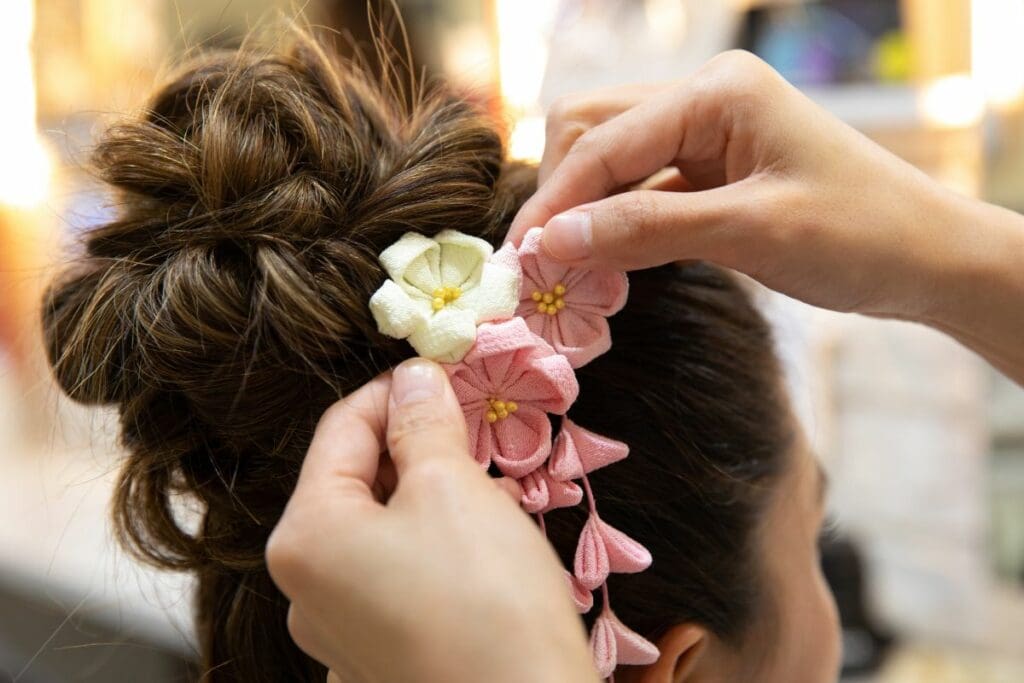
Cultural Sensitivity:
While dressing up can add to the fun and immersive experience, it’s important to approach this aspect with cultural sensitivity and respect. Encourage guests to avoid cultural appropriation by choosing outfits that appreciate the culture without caricaturing it. A brief note in the invitation about appropriate attire can help guide guests in their choices.
By considering these dress code suggestions, you and your guests can enhance the authenticity and enjoyment of your Japanese-themed dinner party, creating a respectful and celebratory atmosphere of Japanese culture.
Hosting Your Japanese Dinner Party
Once you have your menu and decor set, it’s time to bring your Japanese-themed dinner party to life.
Setting Up
- Decor: Arrange your table and room according to your chosen theme, using the decor items and tableware recommended. Ensure everything is in place before the guests arrive.
- Ambience: Consider playing some soft, traditional Japanese music in the background to set the mood. Lighting should be calm and inviting, perhaps with dimmed lights or candles.
The Art of Serving
- Presentation: As each course is served, pay attention to the presentation. Use your Japanese tableware to display the dishes elegantly. Remember, in Japanese cuisine, how the food looks is almost as important as how it tastes.
- Serving Style: Depending on your menu, you might opt for a family-style service or individual plating. Make sure to explain any particular eating utensils or customs related to the dishes being served.
Interactive Activities to Include in a Japanese Dinner Party
Adding interactive elements to your Japanese-themed dinner party can significantly enhance the experience for your guests, making it both educational and entertaining. Here are some recommended activities:
1. Origami Workshop:
- Activity: Set up a small station with origami paper and instructions for simple designs like cranes or flowers. Origami, the art of paper folding, is fun and a great way for guests to engage with Japanese culture.
- Resources: Provide printed step-by-step guides or have a laptop/tablet with tutorial videos.
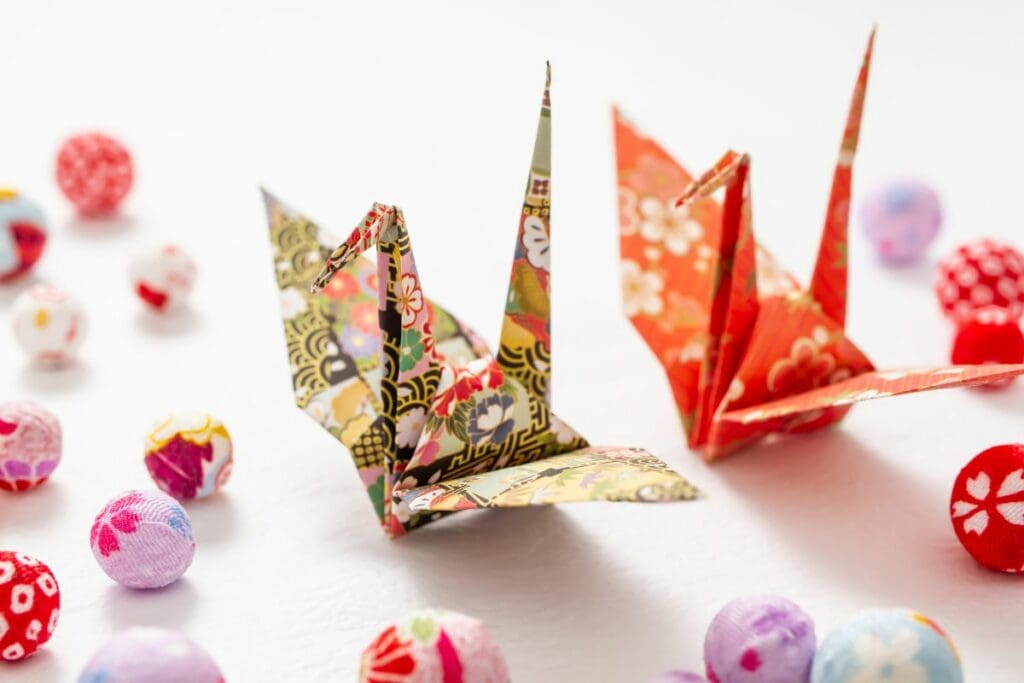
2. Traditional or Modern Japanese Games:
- Go (囲碁): A strategy board game for two players. You can have a Go board set up for guests interested in strategy games.
- Sushi Go: Sushi Go is a contemporary, fast-paced game where players mix and match sushi combinations to score points. Sushi Go is a great option for a larger group to interact with each other.

3. Japanese Calligraphy (書道 – Shodō):
- Activity: Set up a calligraphy corner where guests can try their hand at Japanese calligraphy using brushes and ink. They could write their names or simple Japanese characters.
- Resources: Provide calligraphy paper, brushes, and ink. You can also print out examples of characters for guests to copy.
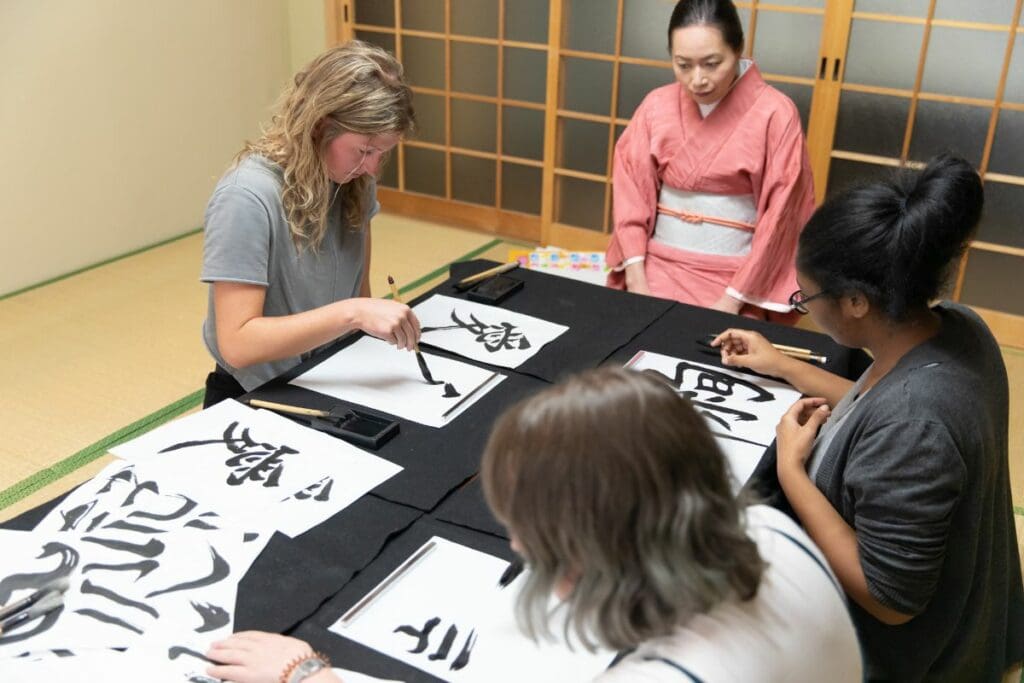
4. Sake Tasting Experience:
- Activity: Host a sake tasting session where guests can sample different types of sake and learn about their flavors and brewing processes.
- Resources: Prepare a variety of sake types and provide small cups for tasting. Optionally, include a brief description or history of each type.
5. Tea Ceremony Demonstration:
- Activity: If possible, arrange for a tea ceremony demonstration. This could be a highlight of the evening, showcasing the ritual and art involved in making traditional Japanese tea.
- Resources: You’ll need a tea ceremony set, which can be purchased online, and you or one of your guests may enjoy learning the tea ceremony and then performing it for your guests.
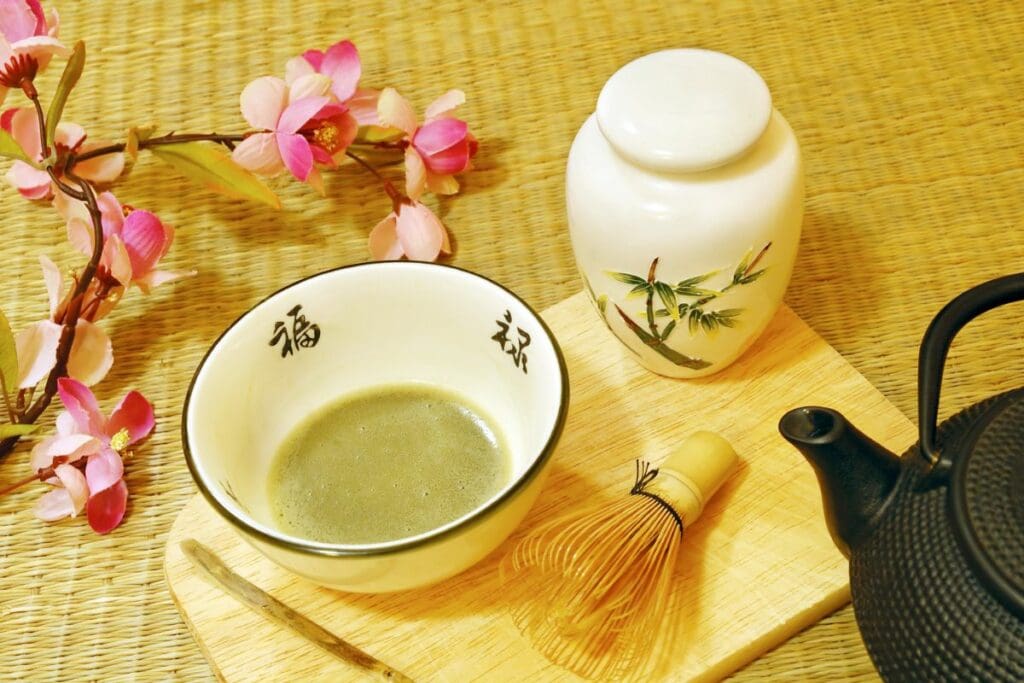
6. Japanese Music and Dance:
- Activity: Play some traditional Japanese music and encourage guests to learn a simple Japanese dance, like the Bon Odori, often performed at festivals. Or mix it up with the latest J-Pop dance moves!
- Resources: Have a playlist of Japanese music and a tutorial video for a simple dance.
These activities not only add an element of fun but also deepen your guests’ appreciation and understanding of Japanese culture. Ensure that each activity is introduced with some background information to enrich the experience.
Conclusion
Your Japanese-themed dinner party is more than just a meal; it’s an immersive experience that celebrates Japan’s rich and nuanced culture. From the carefully prepared dishes in traditional tableware to the thoughtfully chosen decor, every element comes together to create an unforgettable evening. As you conclude the night, encourage your guests to continue exploring the fascinating world of Japanese cuisine and culture.
Resources and Recommendations
To help you prepare for your Japanese-themed dinner party, here is a list of resources and product recommendations from Musubi Kiln and Amazon.
Musubi Kiln Products:
- Long Rectangular Plate
- Japanese Square Plate
- Miso Soup Bowl
- Sake Cup Set
- Wave Crest Series Plate
- Sakura Japanese Tableware
Amazon Product Recommendations:
- Bamboo Placemats
- Zen Garden Table Centerpiece
- Cherry Blossom Table Runner
- Japanese Style Dinnerware Set
- Cherry Blossom Dinnerware Set
Books for Learning About Japanese Dining and Culture:
- “Japanese Cooking: A Simple Art” by Shizuo Tsuji
- “Washoku: Recipes from the Japanese Home Kitchen” by Elizabeth Andoh
- “The Just Bento Cookbook: Everyday Lunches To Go” by Makiko Itoh
These resources will equip you with the necessary tools and knowledge to host an authentic and memorable Japanese-themed dinner party. Enjoy the process of planning, preparing, and celebrating the rich culinary traditions of Japan!
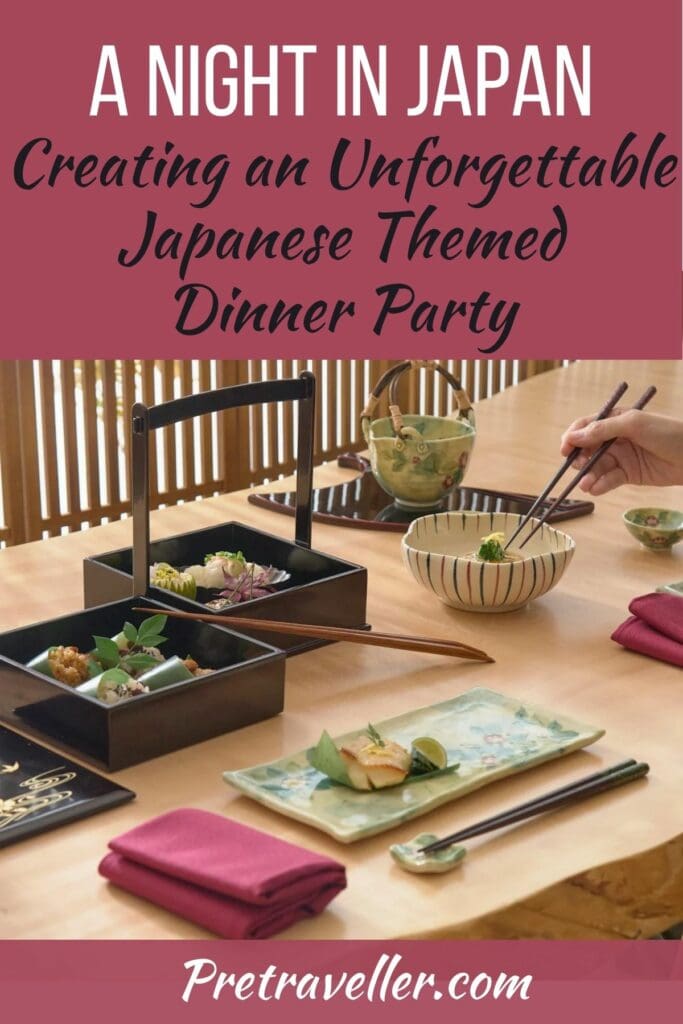
You may also like:
Gorgeous Gifts for Someone Travelling to Japan
How to Buy Japanese Kit Kats Online
Delicious Japanese Snack Subscription Boxes to Devour
Anne Sutherland-Smith is the creative force behind Pretraveller.com, a travel blog that specializes in offering insightful guidance for exploring Japan, South Korea, Australia, Hong Kong, and Singapore. Her passion for these diverse and dynamic regions shines through in her expert advice, particularly in helping travellers stay connected with the latest in SIM cards, pocket WiFi, and eSIMs.
With an unquenchable thirst for Asian and Oceanian cultures, Anne has carved out a niche as a knowledgeable guide for those venturing into the bustling streets of Tokyo, the historical alleys of Kyoto, the vibrant scenes of Seoul, the scenic landscapes of Australia, the vibrant markets of Hong Kong, or the futuristic cityscape of Singapore. Her articles are full of practical tips and detailed information, ensuring travellers are well-equipped for their journeys.
Anne’s approach is grounded in providing reliable, authoritative travel content that enhances the travel experience. From navigating the complexities of digital connectivity on the go to immersing in the local culture, her advice is designed to make travel both enjoyable and seamless.

